
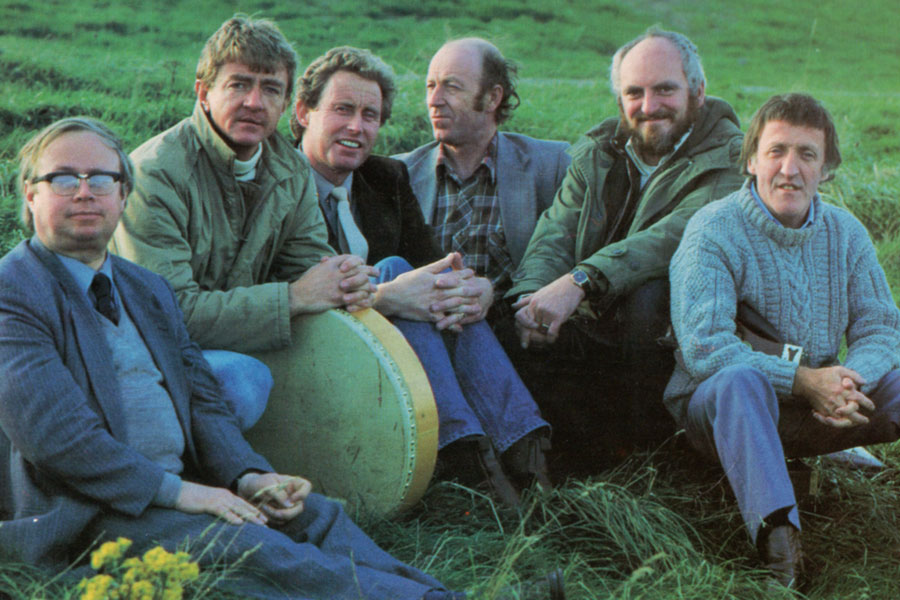
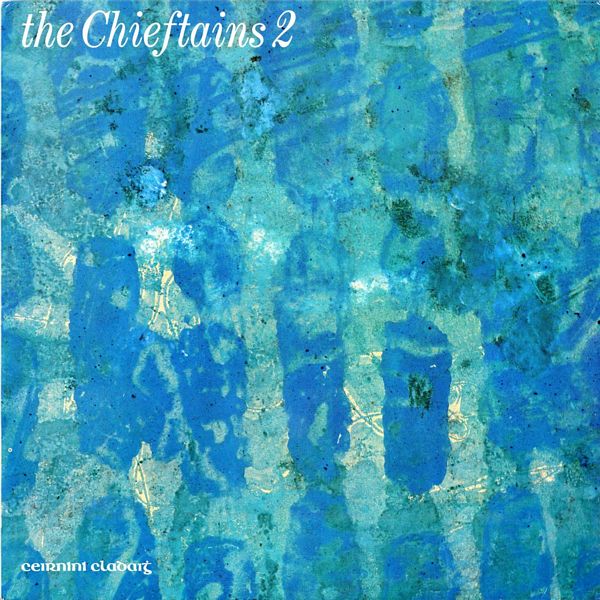 |
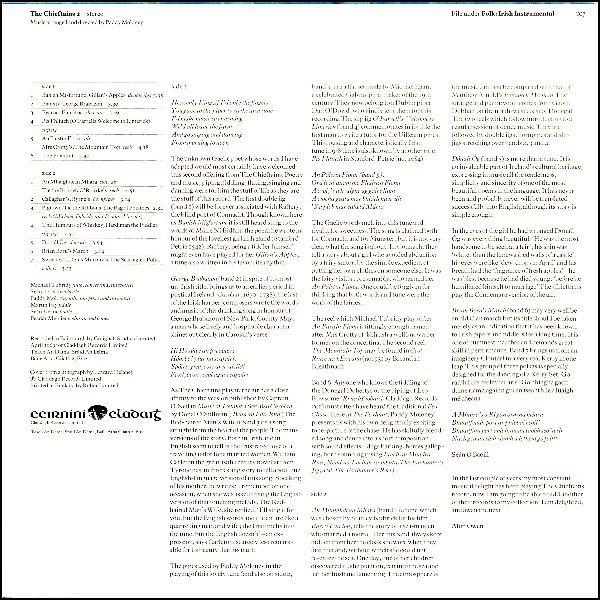
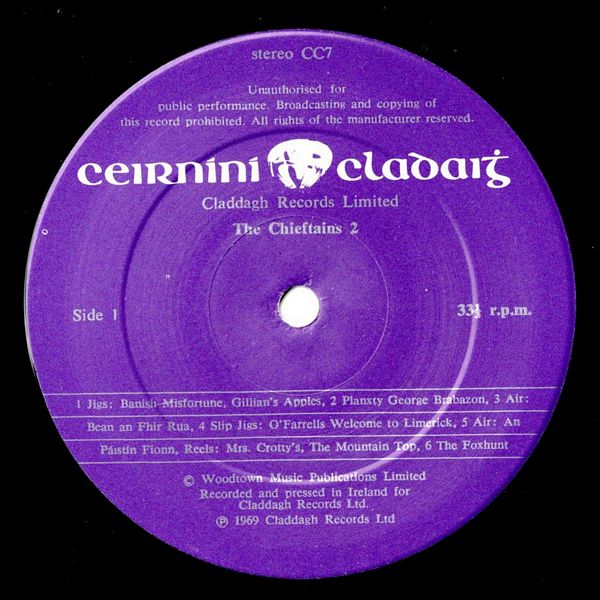
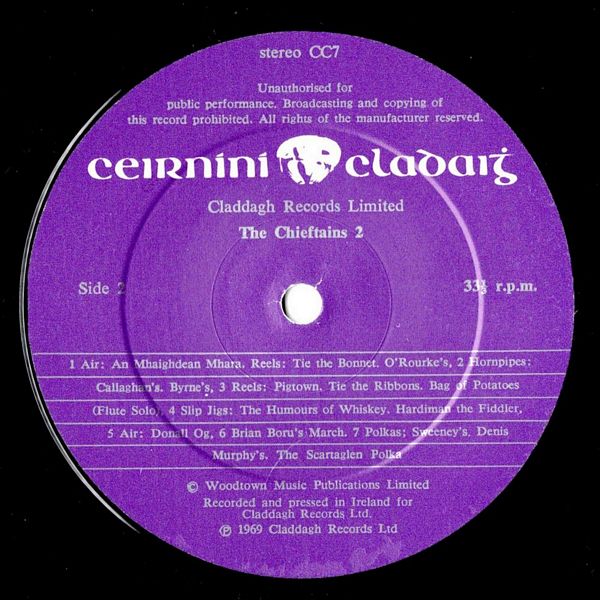 |
Sleeve Notes
Heavenly King, if I'd only the fingers
You gave to the piper to strike up a tune
I'd make music so charming
We'd all leave the farm
And go singing and dancing
From morning to noon
The unknown Gaelic poet whose words I have adapted would most certainly have welcomed this second offering from The Chieftains. Poetry and music, piping, fiddling, fluting, singing and dancing were for him the stuff of life as they are the stuff of this record. The first double jig (band 1) will be forever associated with Raftery, the blind poet of Connacht. Though known here as Banish Misfortune it is still heard sung to the words of Máire Ní Éidhin, the poem he wrote in honour of the loveliest girl in Ireland (Stanford-Petrie 1542). Raftery, being a fiddler himself might even have played for her Gillan's Apples, a tune also written in his favourite rhythm.
George Brabazon (band 2) in spite of its most un-Irish title, brings us to an earlier period in poetical Ireland. Carolan (1670-1738), the last of the Irish harper-composers wrote the words and music of this drinking song in honour of George Brabazon of New Park, County Mayo — a man whose lively and hospitable character shines out clearly in Carolan's verse:
Hí Hó súd É an preabaire
Hóm bó! plúr na scafairí
Spóirt, gleo, cosc ar n-aiciídí
Feoil, beoir, ceol agus ceapairi
As The Chieftains play it, the air has a close affinity to the version published by Captain O'Neil in Music of Ireland. (See also Carolan by Donal O'Sullivan.) Bean an Fhir Rua (The Red-haired Man's Wife, band 3) is a song straight from the heart of the people. The many versions of the story, both in Irish and in English seem to tell of the frustrated love of a travelling tailor for a married woman. William Carleton the great 19th century novelist from Tyrone has an interesting story to tell about one English-language version of this song. Speaking of his mother, he writes: I remember on one occasion, when she was asked to sing the English version of that touching melody, The Red-haired Man's Wife, she replied, 'I'll sing it for you, but the English words and the air are like a quarrelling man and wife; the Irish melts into the tune, but the English doesn't' — an expression, says Carleton, scarcely less remarkable for its beauty than its truth.
The pipes used by Paddy Moloney in the playing of this lovely tune (and also on side 2, band 5) are a flat set made by Michael Egan, a celebrated Galway pipe-maker of the 19th century. They now belong to a Dublin piper Dan O'Dowd, who kindly lent them for this recording. The slip jig O'Farrell's Welcome to Limerick (band 4) commemorates in its title the first man to write a tutor for the Uilleann pipes. This rousing and characteristically Irish tune in 9/8 time is also known by another title Pis Fhliuch in Stanford-Petrie (no. 1084).
An Páistín Fionn (band 5).
Grále m'anam mo Pháistín Fionn
A croí, 's a h-aigne aggáire liúm
A cíocha geala mar bhláth na n-úll
'S a píob mar eala lá Márta
The Gaelic words melt into this tune and rival it for sweetness. The song is claimed both for Connacht and for Munster, but it is not very clear what the song is about. In Connacht they tell a story about a girl who avoided abduction by a fairy suitor, by the simple expedient of putting her own clothes on someone else. It was the fairy visitor, presumably, who named her An Páistín Fionn. One could be forgiven for thinking that both words and tune were the work of the fairies.
The reel which Michael Tubridy plays after An Páistín Fionn is fittingly enough named after Mrs Crotty of Kilrush a well known performer on the concertina. The second reel The Mountain Top may be found in Ceol Rince na hÉireann (no. 93) by Breandán Breathnach.
Band 6. Anyone who knows the fiddling of the Donegal Dohertys or the piping of Leo Rowsome (Rí na bPíobairí, Claddagh Records CCI) must often have heard the traditional Fox Chase. Here in The Foxhunt, Paddy Moloney presents us with his own delightfully exciting tone-picture of the chase. He has skilfully blended song and dance into a short composition with sound effects — dogs barking, horses galloping, horn sounding (using Fiach an Mhadra Rua, Nead na Lachan sa mbúta, The Foxhunter's Jig, and The Foxhunter's Reel).
An Mhaighdean Mhara (band 1) a tune which was chosen by Stanley Kubrick for his film Barry Lyndon, tells the story of a sea-maiden who married a mortal. Her husband always kept hidden from her the cloak she wore when they first met and, without which she could not re-enter the sea. One day, one of her children discovered it; she put it on, ran into the sea and left her husband lamenting. The atmosphere of the music can best be compared with that of Matthew Arnold's Forsaken Merman. The strange and plaintive air comes from Gaoth Dobhair on the north-west coast of Donegal. The two reels which follow introduce us to a regular session of dance music. They are followed by double jigs, hornpipes and slip jigs stretching over bands 2, 3 and 4.
Donall óg (band 5) is more than a tune. It is an invaluable part of Ireland's cultural heritage, expressing in music all the tenderness, simplicity and sincerity of one of the most beautiful poems in the language. It has never been and probably never will be translated successfully into English, although its story is simple enough.
In the eyes of the girl he had wronged Dónall óg was everything beautiful. 'He was the most handsome to be seen at a fair'; his skin was 'whiter than the limewashed walls of a castle', his eyes were like 'dew-drops in April' and his breath had the 'fragrance of fresh apples' — he was blest because he had died young, 'before he humiliated himself to marriage' The Chieftains play the Connemara version of the air.
Brian Boru's March (band 6) may very well be an old Clan march but its title should be taken merely as an indication that it has been known to Irish pipers and fiddlers for a long time. It is one of our finest marches and demands great skill in performance. Band 7 brings us from an imaginery Clontarf to a very real Kerry in one leap. This group of three polkas is specially designed for the dancing of a Kerry Set. Go raibh Éire ceolmhar arís! Go bhfagha gach duine riamh againn guí an tseanfhile a luaigh mÉ cheana:
A Mhuire's a Rígan orm na mÉara
Bhuailfeadh port ar phíobaí ceoil!
Bhuailfinn port aoibhinn an taobh seo 'n tír
Nach gcuala sibh riamh a lÉthÉid go fóill!
Seán Ó Baoill
In the last couple of years my most constant musical delight has been playing The Chieftains record, now I am going to be able to add another of their records to my collection. I am delighted, and await the next.
Alun Owen